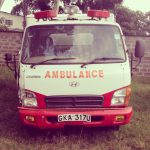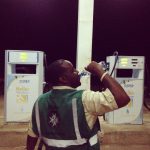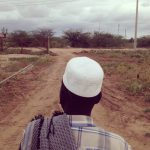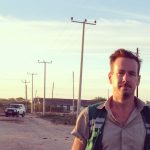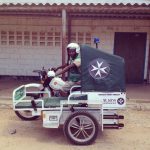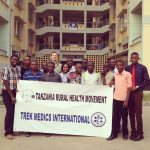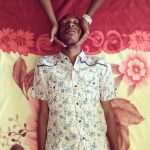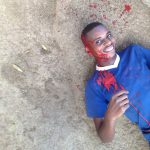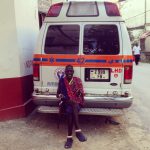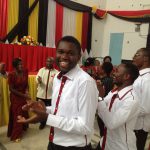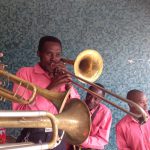Kenya
Even for seasoned travelers, arriving in central Nairobi, Kenya, during afternoon rush hour is a hectic experience. Local ‘matador’ buses spew exhaust, revving their engines as if picking a fight with the snaking queues waiting to board. The traffic is packed so tight even motorbikes are jammed. How do ambulances get around in this city? I don’t have to wonder long. Within a few days I’m on one.
Stellah Sakina, EMT with St John Kenya, gets out of her ambulance and moves deftly between stuck vehicles, asking drivers to move just a little more left, another to take some vacant space against a gutter. We can squeeze ahead, bit by bit, a fraction closer to our call. Slowly we follow behind Stellah as she walks through evening traffic, lane splitting on foot to guide us through.
Much as I’d have welcomed the opportunity to work with pre-hospital services in an African mega-city, my mission as a Trek Medics’ delegate to East Africa is clear: work with the Kenyan national EMS provider St John Ambulance on a first responder pilot program in two rural counties: Machokos and Tana River counties. The team is made up of Lotern Brown, St John project manager, and Malachi Omolo, IT support. But before we head into the wilderness, I’m given an official invitation to the St John annual parade. It’s as much the spectacle it was expected to be, all brass bands and impressive marching tricks and even a simulated childbirth responded to by St John ‘Badgers’, first aiders no older than eight.
We drove to Machakos County, a couple of hours out of Nairobi through plains inhabited by grazing zebras and stopped briefly at a St John demountable on the highway to inspect rescue teams. Not a day goes by without an incident on this stretch of road. Proceeding on we came across a remarkably developed county, which locals attributed to their beloved governor Alfred Mutua. His personal interest in efficient emergency services is renown. Early this year he bought the county seventy ambulances and within months Machakos was the only county in Kenya to begin using the national emergency number ‘999’. We inspected this call centre and noted that, while contacting emergency services had been made easy for the public here, ambulances were being dispatched by phone call. Machakos, for this reason, is considering incorporating our ‘Beacon’ dispatch software into their existing communications system, which will streamline their communications, capture call data and turn responder mobile phones into handheld MDTs for dispatch.
Much further south, in Tana River County, things are a little different. The day before our flight, Lotern was involved in a serious car accident. After colliding with another vehicle, his car almost overturned. Then, while stumbling about the scene nursing superficial injuries, bystanders robbed him of his wallet, phone and laptop at gunpoint. This is not uncommon in some suburbs of Nairobi, criminal elements waiting for a moment of weakness in which to strike. I wonder if the guarantee of rapid, 24-7 emergency medical services might help to deter the criminal elements that are filling the void.
It’s a mission to get to Tana River, involving a flight to Mombassa and six hours along badly corrugated and pot-holed roads. Our journey is accompanied by a selection of hymns played on the phone of the devout St John IT officer, Malachi Omolo. Workers at St John are overwhelmingly Christian, yet the Muslim population of Tana River has accepted and embraced the work of St John in their county. This is one of the beauties of Kenya, that despite hundreds having died here at the hands of cross-border terrorist attacks by Al Shabab militants over the past three years, people refuse to let it divide them. At least for now.The dusty county, its northern border along the crocodile-infested Tana River, is home to around 300,000 people. Only 10,000 of these live in the main town of Hola. The rest of the partly nomadic population is spread out across an vast, semi-arid area the size of France. Perhaps that is why the French Consulate in Nairobi donated four eRanger motorbikes to be run here by St John. Our local contact Hassan Wario is a landowner and long-serving St John volunteer tasked with running ten 4×4 ambulances the county has bought. We inspected these vehicles, locked away for the time being in the grounds of the county governor’s private villa. But the keys are with Hassan, and the keys to the eRangers too. No one will get them until Tana River launches its first ever emergency medical service next month, lest the vehicles disappear into the desert, as so often happens with donated ambulances, never to be seen again.
We had a successful meeting with the health minister Salim Mohammad and provided him with a live demonstration of our ‘Beacon’ dispatch system, which he found very impressive. Then we examined the catchment area (size of France, remember) and discussed how, or if, this could be adequately served with ten ambulances and four motorbikes. At this juncture I introduced the notion of community resources as valuable assets. Train locals as first responders, teach them how to build and maintain a kit, connect them with ‘Beacon’ on their phones, use whatever vehicle available and begin the journey, arranging an ambulance rendezvous wherever possible. In this county many die from delays, from arduous community discussions before a patient is mobilized to definitive care, from poor knowledge about identifying critical patients and what to do about it. Along with Hassan we began to outline a strategy for building a comprehensive first responder system using all available resources, both formal and informal.
Later on that day we took the two hour journey into the interior of Tana River to the village of Wayu. Here the locals live among dust and wind, children walk miles for water, women stare from doorways of grass huts. When the village chief put out the call for a community meeting, it didn’t take long for gaunt men, thin as the sticks holding up their homes, to emerge from the dry scrub. All of them looked like they needed a long drink. We sat and discuss their worries. Last month, two children belonging to one man suffered snakebites. One child went to rescue his brother who’d been bitten, and the snake struck the second child too. No one knew what to do. The first child died before they could reach help and the second child still cannot walk properly. There are stories of obstructive labour, of stabbings from tribal clashes, of injuries from cattle while herding. Where is the help, they asked? There’s no one to call. Lotern reassures them that one of the ambulances bought by the county will soon be stationed at Wayu, as will at least two of the eRanger bikes designed for reaching patients across the plains where there are no roads. If all goes well, these resources will be connected by Trek Medic’s ‘Beacon’ software and their activation reliant on a simple call or text from those in need. Already Hassan has begun teaching locals first aid and this will be further expanded after we consulted with him on first responder training matters.
Back in Nairobi I met with various other players in the mobile health sector. It became apparent to me quickly that Kenya is an African technology hub with a wealth of talent in software development and mobile solutions. Many were impressed with the functionality of Beacon and its potential to revolutionize emergency medical response in rural areas. The newly decentralized government has paved the way for counties to work on their own EMS capability and many are proactively doing just that. By building relationships with the reputable St John Ambulance, Trek Medics is excited to make the most of this opportunity to improve delivery of pre-hospital care in the rapidly developing nation of Kenya.
Tanzania
Along the eastern shore of Lake Victoria lies the second largest Tanzanian city, Mwanza. It’s also known as ‘rock city’, attributed to the thousands of boulders that lie scattered like enormous marbles throughout the town. Here Trek Medics is partnering with the Tanzania Rural Health Movement (TRHM), an NGO comprised in large part by local medical and nursing students who have taken proactive measures to address unmet social and health problems in their community.
Director of TRHM, Marko Hingi, is in his final year of medicine. On placements in the emergency room of Bugando Hospital he experienced the frustration of receiving poorly handled victims of road accidents. Patients typically arrive more than an hour after their injuries, usually in the back of a police pick-up, and having received no pre-hospital care whatsoever. These delays, coupled with lack of treatment in the field, has contributed to the high rates of trauma morbidity and mortality in Mwanza. On average the hospital emergency department sees eighty patients a day, with at least ten of these being serious injuries related to physical trauma. Marko Hingi of TRHM and his group of volunteers, supported by other stakeholders in the local health establishment, approached Trek Medics International to help them turn the tide on this escalating health problem in a city without public ambulance services.
He’s an engaging character, Marko. His passion and drive is a force to be reckoned with, and the motivational speeches he gives to his team elicits attention that is equally from respect as it is from his ability to transfix an audience. As for the volunteers, they’re young, smart and friendly, and they meet several times a week to workshop health solutions for Mwanza, such as their wound care project. On my first Saturday I joined them as they set up a tent in a dusty parking lot, their make-shift clinic. At first I wondered where their customers were. But we didn’t have to wait long. A steady trail of grubby street kids began arriving, many with worn-down shoes, or no footwear at all. Adventures through the dangerous trash heaps of Mwanza typically leave these children with wounds prone to festering and becoming septic. They lack access to running water and ability to keep clean. As they had their wounds dressed, they sang Swahili songs to us (and even a song about butterflies in English, just for me) and were full of life and smiles and gratitude. This is the work of Marko and his gang, filling the gaps in public healthcare.
The lack of Emergency Medical Services (EMS) is another such gap, and one with serious implications here. A recent study by doctors at Bugando Hospital here, describe the impact of a rising trend in motorcycle ownership by young men and how it has lead to a spike in trauma. But the only ambulance donated to Bugando three years ago, a Mercedes Sprinter, broke down two months later and never got going again. The hospital couldn’t afford its repair — a story we’ve all heard before, and that I’ve encountered myself time and time again in my travels through low- and middle-income nations, countries littered with the rusting shells of former European, Australian and American ambulances. The gesture was nice, but one of the common weaknesses of foreign aid has always been sustainability.
Marko and I began work quickly. We conducted a 3-day First Responder training course, taking into the account the pre-existing knowledge of the students. Some of their answers to questions surprised me. When asked to reflect on dangers that might exist at the scene of emergencies, the top two answers were crocodiles and bandits. Indeed, only a fool would jump into Lake Victoria after a victim of drowning in case they should be consumed by the fresh water crocodiles lurking there. Only a day earlier, when I took a canoe to a nearby island of zebras, I’d seen one myself, sun-baking on a rock. As for bandits, I recalled the experience of a friend in Kenya who’d been robbed after an accident. Here too there are people who will see a patient as an easy target and car crashes as tempting opportunities. I wonder if our responders will be patting down patients, checking for injuries, while bystanders pat them down for their wallet? Or perhaps there’s strength in numbers and safety in crowds.
After the course was completed, we recruited a group of taxi drivers and bodaboda motorcycle riders, essentially motorbike taxis. Our vision is that, in the absence of formal ambulance services, these resources can be deployed instead. A separate course was run for these taxi and motorcycle riders, culminating in several simulations. Our first, a classroom simulation of Trek Medic’s ‘Beacon’ dispatch software was conducted where emergency responses were initiated and run on participants’ mobile phones. Then, the following day, we set up an exercise: two emergencies running simultaneously in two separate quarters of the city. Two teams of responders were arranged, each team comprised of two volunteers on foot, one motorbike and one taxi, all positioned in separate locations. Incident #1 was a male fallen from a boulder (it was rock city, after all) suffering a head injury and decreased consciousness. Incident #2 involved two patients struck by a passing lorry, one unconscious with a head injury and the other conscious, nursing a fractured lower arm. Fake blood was prepared, limited first aid supplies handed out (length of cardboard for a splint, blanket for a stretcher etc) and once everyone was in position the incidents were called in. Using our Beacon software, first responders were alerted to the location by text message. They then replied with their ETA and were instructed by text to proceed. A few hitches were encountered with locating one incident (few street numbers exist in Tanzania, most just use descriptions like ‘the red house’) and the boulder case came to a grinding halt when a shepherd decided to herd his cattle over the top of the patient. But all in all, it was an enjoyable exercise and demonstrated to all the beauty and simplicity of a community first response system in action: The simplicity of basic first aid skills that save the most patients; the simplicity of text messages to dispatch; the simplicity and common sense of using whatever transport means are available in environments without ambulances.
Trek Medics and TRHM met with the Honorable Mayor of Mwanza, Stanslaus Mabula, who showed his support for a first responder program. He told us that discussions he’d had with various other foreign EMS agencies previously come to naught, mainly due to the costs implications of the modern systems they proposed. It was great to get such high level support for our mission, and we’re glad to see him getting behind TRHM.
We also toured the emergency department at Bugando, met with hospital officials and surveyed locals in the street. Finally, after several further meetings with Marko Hingi, we had an official ceremony at which Trek Medics International signed an MOU with the Tanzania Rural Health Movement (TRHM) to prepare and conduct a 6-month pilot program in Mwanza. On the same afternoon, students of our first responder course received their certificates and we celebrated on the rooftop of the student hostel at Bugando Hospital, watching the sun set over Lake Victoria.
This new partnership is an exciting one for all of us, and we’re eager to make the most of a consistently dire situation.


